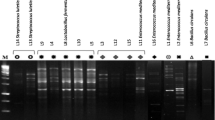Abstract
To investigate the effect of starter isolated from kimchi, we selected the most effective strain among the 121 strains examined and identified the strain as Leuconostoc mesenteroides LK93 through 16S rDNA sequencing. This strain exhibited resistance to acid and bile salts with good survival capacity and showed antimicrobial and antifungal activity. We investigated the effects of starter on kimchi fermentation. The kimchi was fermented at 25°C for 25 d. Furthermore, the LK93 strain was examined for its ability to inhibit the growth of film-forming yeast. It was determined that the LK93 strain could be a potential starter in kimchi.
Similar content being viewed by others
References
Kong CS, Kim DK, Rhee SH, Rho CW, Hwang HJ, Choi KL, Park KY. Fermentation properties and in vitro anticancer effect of young radish kimchi and young radish watery kimchi. J Korean Soc. Food Sci. Nutr. 34: 311–316 (2005)
Lee CH. Lactic acid fermented foods and their benefits in Asia. Food Cont. 8: 259–269 (1997)
Kim DM, Lee JH. Current status of Korean kimchi industry and R&D trends. Food Ind. Nutr. 6: 52–59 (2001)
Park EJ, Chun JS, Cha CJ, Park WS, Jeon CO, Bae JW. Bacterial community analysis during fermentation of ten representative kinds of kimchi with barcoded pyrosequencing. Food Microbiol. 30: 197–204 (2012)
Park HJ, Park YH, Kim YB. Characterization of growth and ethanol formation of Weissella paramesenteroides. Food Sci. Biotechnol. 10: 2–75 (2001)
Jang JK, Han J. The antioxidant ability of grape seed extracts. Korean J. Food Sci. Technol. 34: 524–528 (2002)
Sobrino OJ, Rodriguez JM, Moreira WL, Fernandez MF, Sanz B, Hernandez PE. Antibacterial activity of Lactobacillus sake isolated from dry fermented sausages. Int. J. Food Microbiol. 13: 1–10 (1991)
Gilliland SE, Staley TE, Bush LJ. Importance of bile tolerance of Lactobacillus acidophilus used as a dietary adjunct. J. Dairy Sci. 67: 3045–3051 (1984)
Jung JY, Lee SH, Kim JM, Park MS, Bae JW, Hahn YS, Madsen EL, Jeon CO. Metagenomic analysis of kimchi, a traditional Korean fermented food. Appl. Environ. Microbiol. 77: 2264–2274 (2011)
Kim JS, Bang JH, Beuchat LR, Kim HK, Ryu JH. Controlled fermentation of kimchi using naturally occurring antimicrobial agents. Food Microbiol. 32: 20–31 (2012)
Park JM, Shin JH, Lee DW, Song JC, Suh HJ, Chang UJ, Kim JM. Identification of the lactic acid bacteria in kimchi according to initial and over-ripened fermentation using PCR and 16S rRNA gene sequence analysis. Food Sci. Biotechnol. 19: 541–546 (2010)
Hemme D, Catherine FS. Leuconostoc, characteristics, use in dairy technology and prospects in functional foods. Int. Dairy J. 14: 467–494 (2004)
Tsai CC, Hshi HY, Chiu HH, Lai YY, Liu JH, Yu B. Antagonistic activity against Salmonella infection in vitro and in vivo for two Lactobacillus strains from swine and poultry. Int. J. Food Microbiol. 102: 185–194 (2005)
Mishra V, Prasad DN. Application of in vitro methods for selection of Lactobacillus casei strains as potential probiotics. Int. J. Food Microbiol. 103: 109–115 (2005)
De Man JC, Rogosa M. Sharpe ME. A medium for the cultivation of Lactobacilli. J. Appl. Bacteriol. 23: 130–135 (1960)
Choi YR. Microbiota profiles of manufactured-kimchi depending on fermentation and growth inhibition of film-foriming yeasts by kimchi lactic acid bacteria. MS thesis, University of Chosun, Gwangju, Korea (2010)
Mohammad AN, Karamatollah R, Mohammad S, Seyyed HR. Effects of several starter cultures on the anti-mold activity and sensory attributes of a traditional flat bread (Sangak) from Iran. Food Sci. Biotechnol. 21: 113–121 (2012)
Le-Dinh H, Kyung KH. Inhibition of yeast film formation in fermented vegetables by materials derived from garlic using cucumber pickle fermentation as a model system. Food Sci. Biotechnol. 15: 469–473 (2006)
Magnusson J, Schnurer J. Lactobacillus coryniformis subsp. coryniformis strains Si3 produces a broad-spectrum proteinaceous antifungal compound. Appl. Environ. Microbiol. 67: 1–5 (2001)
Lavermicocca P, Valerio F, Evidente A, Lazzaroni S, Corsetti A, Gobetti M. Purification and characterization of novel antifungal compounds from the sourdough Lactobacillus plantarum strain 21B. Appl. Environ. Microbiol. 66: 4084–4090 (2000)
Kim JS, Bang JH, Beuchat LR, Kim HK, Ryu JH. Controlled fermentation of kimchi using naturally occurring antimicrobial agents. Food Microbiol. 32: 20–31 (2012)
Author information
Authors and Affiliations
Corresponding author
Rights and permissions
About this article
Cite this article
Park, JM., Shin, JH., Bak, DJ. et al. Effect of a Leuconostoc mesenteroides strain as a starter culture isolated from the kimchi. Food Sci Biotechnol 22, 1729–1733 (2013). https://doi.org/10.1007/s10068-013-0273-8
Received:
Revised:
Accepted:
Published:
Issue Date:
DOI: https://doi.org/10.1007/s10068-013-0273-8




